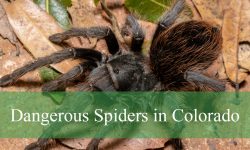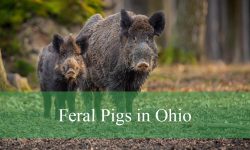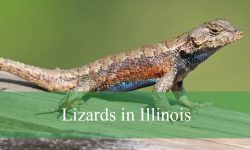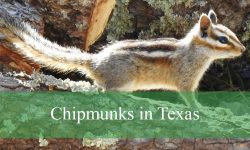Florida is home to a diverse range of wildlife, including some of the most dangerous animals in the United States. From venomous snakes to powerful predators, these creatures can pose serious risks to people who live in or visit the state. Knowing which animals to watch out for is essential for staying safe.
This article explores the 25 most dangerous animals in Florida, complete with pictures to help you identify them easily. Hiking in the Everglades, swimming along the coast, or spending time outdoors means it’s important to recognize these animals and understand the risks they pose.
By learning about the behavior, habitat, and threats of the most dangerous animals in Florida, you can avoid risky encounters and respond appropriately if you encounter one. Keep reading to discover these fascinating but potentially hazardous creatures.
The Most Dangerous Animals Found in Florida
American Alligator

The American alligator (Alligator mississippiensis) is a massive reptile with dark, rough skin and a broad, rounded snout. Adults often exceed 13 feet in length and can weigh over 1,000 pounds. Their powerful jaws are lined with conical teeth designed to crush prey, making them one of Florida’s most formidable native predators.
Although attacks on humans are rare, they do happen, especially when people get too close during breeding season or attempt to feed them. Their bite can be fatal or cause severe trauma due to the sheer force and risk of infection. Alligators are most dangerous when surprised or defending their nests.
They are widespread across Florida, commonly inhabiting freshwater swamps, marshes, lakes, and slow-moving rivers. They are especially abundant in the Everglades and wetlands throughout central and northern parts of the state. While they often avoid human contact, they may venture into residential areas with water features.
American Crocodile

The American crocodile (Crocodylus acutus) is a large reptile distinguished from alligators by its slender V-shaped snout and a lighter, gray-green coloration. It can grow up to 16 feet long and has visible teeth that protrude even when its mouth is closed. Its body is well adapted for coastal and brackish environments.
Unlike the more common alligator, the American crocodile is shy and tends to avoid humans. However, it can be dangerous if provoked, especially during nesting season. Though attacks are rare, they are possible due to the crocodile’s size and strength.
This species is found primarily in South Florida, particularly in the Florida Keys, Everglades National Park, and coastal mangrove swamps. They prefer warm, saltwater habitats and are considered a conservation success story due to recovery efforts after past population declines.
Cottonmouth (Water Moccasin)
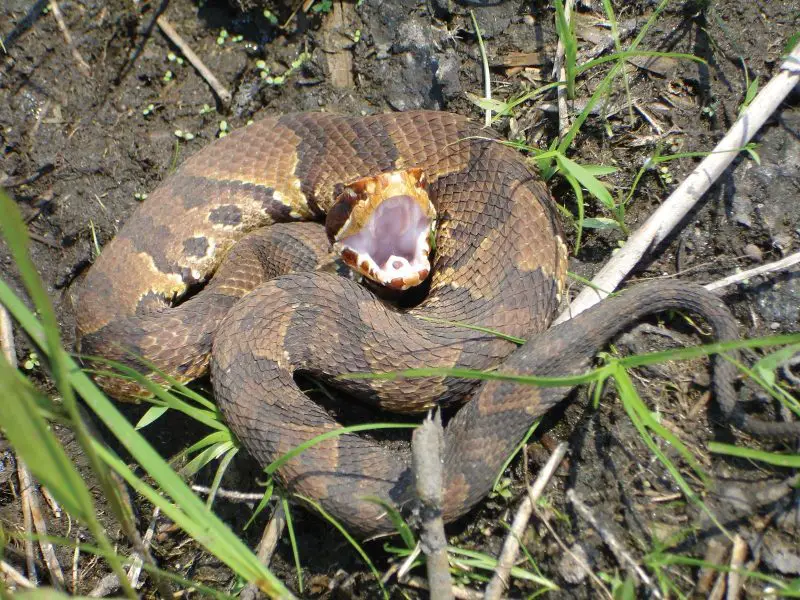
The cottonmouth (Agkistrodon piscivorus), commonly known as the water moccasin, is a venomous snake with a thick body and a distinctive triangular head. Its coloration ranges from dark olive to almost black, often with faint crossbands. When threatened, it opens its mouth to reveal the white interior—a key identifying behavior.
Cottonmouths possess cytotoxic venom that causes severe tissue damage, swelling, and pain. While bites are rarely fatal with modern medical care, they can result in serious injuries or infections. This species is known for standing its ground and may exhibit aggressive defensive behavior when disturbed.
These snakes are commonly found near or in water throughout Florida, including swamps, streams, lakes, and drainage ditches. They are especially prevalent in the northern and central parts of the state but can be encountered in a variety of wetland environments, even in urban areas.
Eastern Diamondback Rattlesnake
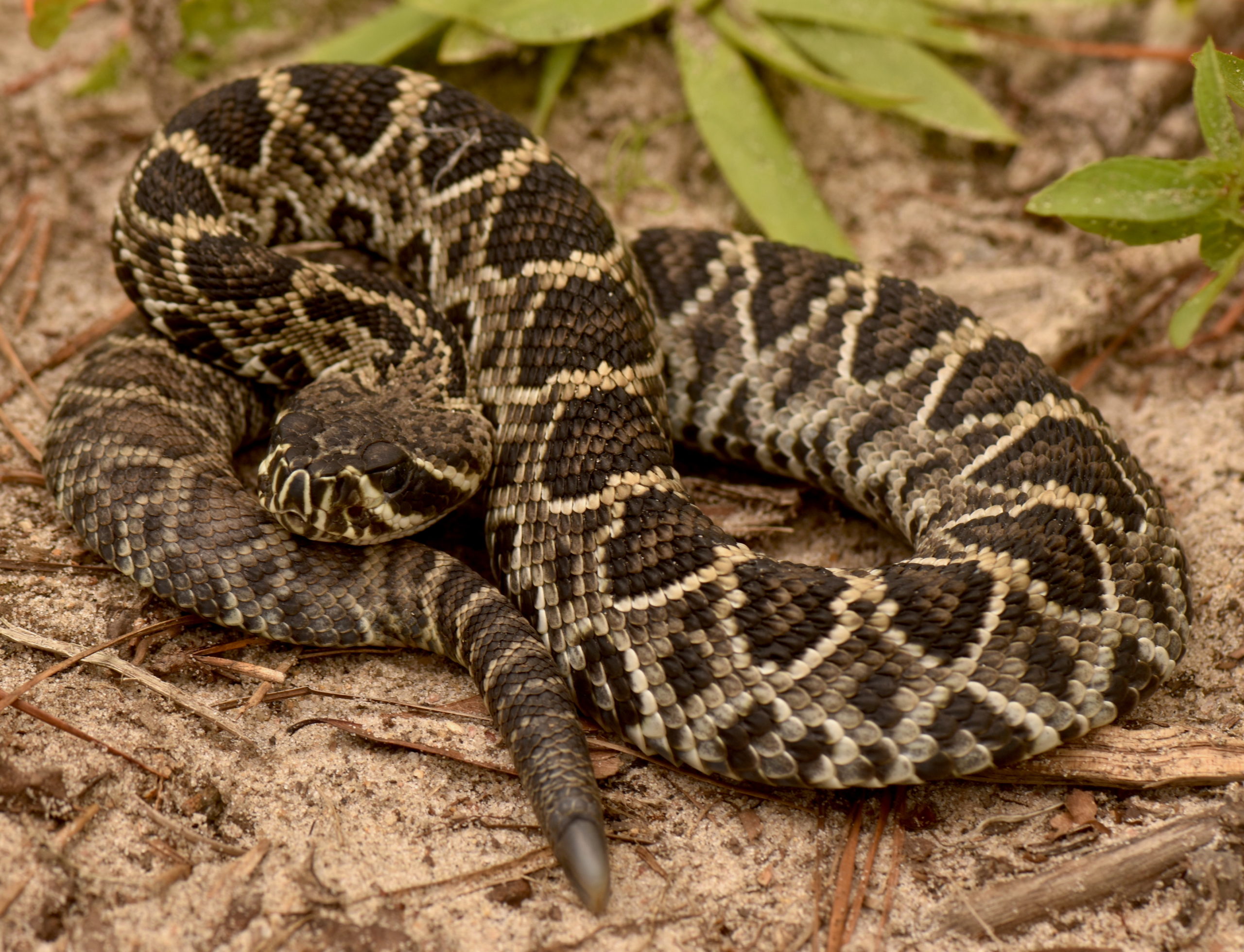
The eastern diamondback rattlesnake (Crotalus adamanteus) is the largest venomous snake in North America, reaching lengths of up to 8 feet. It has a heavy body with dark diamond-shaped markings outlined in cream along its back and a rattle on its tail that produces a loud buzzing warning.
Its venom is hemotoxic, destroying tissue and blood cells, and can be fatal without prompt antivenom treatment. While generally reclusive, the diamondback may strike if cornered or surprised. Its warning rattle typically precedes any strike, but encounters can still be dangerous, especially in tall grass or brush.
This rattlesnake inhabits pine flatwoods, sandhills, dry prairies, and coastal scrub habitats throughout Florida, particularly in the northern and central regions. It avoids heavily developed areas but may still be found near hiking trails and undeveloped land.
Dusky Pygmy Rattlesnake
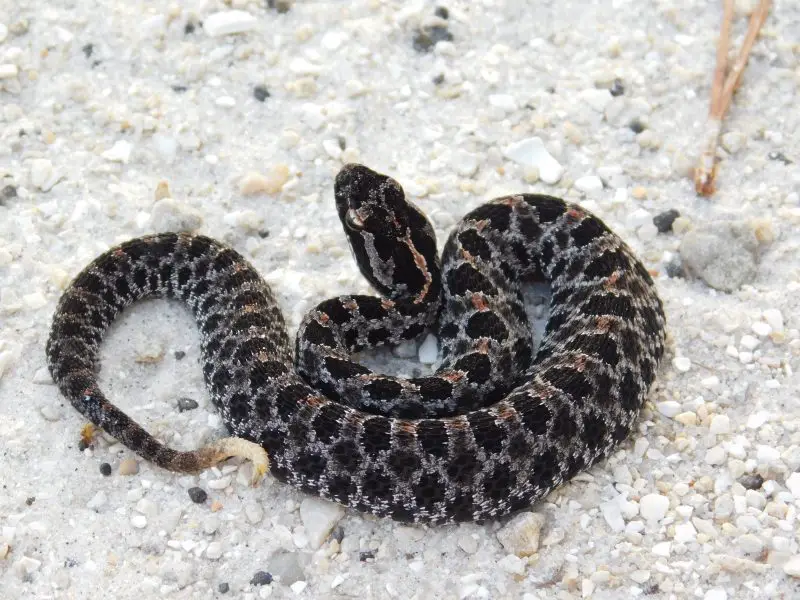
The dusky pygmy rattlesnake (Sistrurus miliarius barbouri) is a small but highly venomous snake, usually growing only 1 to 2 feet long. It has a gray to dark gray body with a series of black blotches running along its back and tiny rattles that produce a barely audible sound.
Despite its small size, the pygmy rattlesnake delivers a venomous bite that can cause intense pain, swelling, and local tissue damage. While its venom is less deadly than that of larger rattlesnakes, it poses a serious health risk, especially to children and pets. The snake may strike quickly when disturbed.
It is widespread across Florida and thrives in a variety of habitats including pine forests, scrublands, marshes, and even suburban neighborhoods. Its secretive nature and good camouflage make it easy to overlook, increasing the chances of accidental encounters.
Eastern Coral Snake
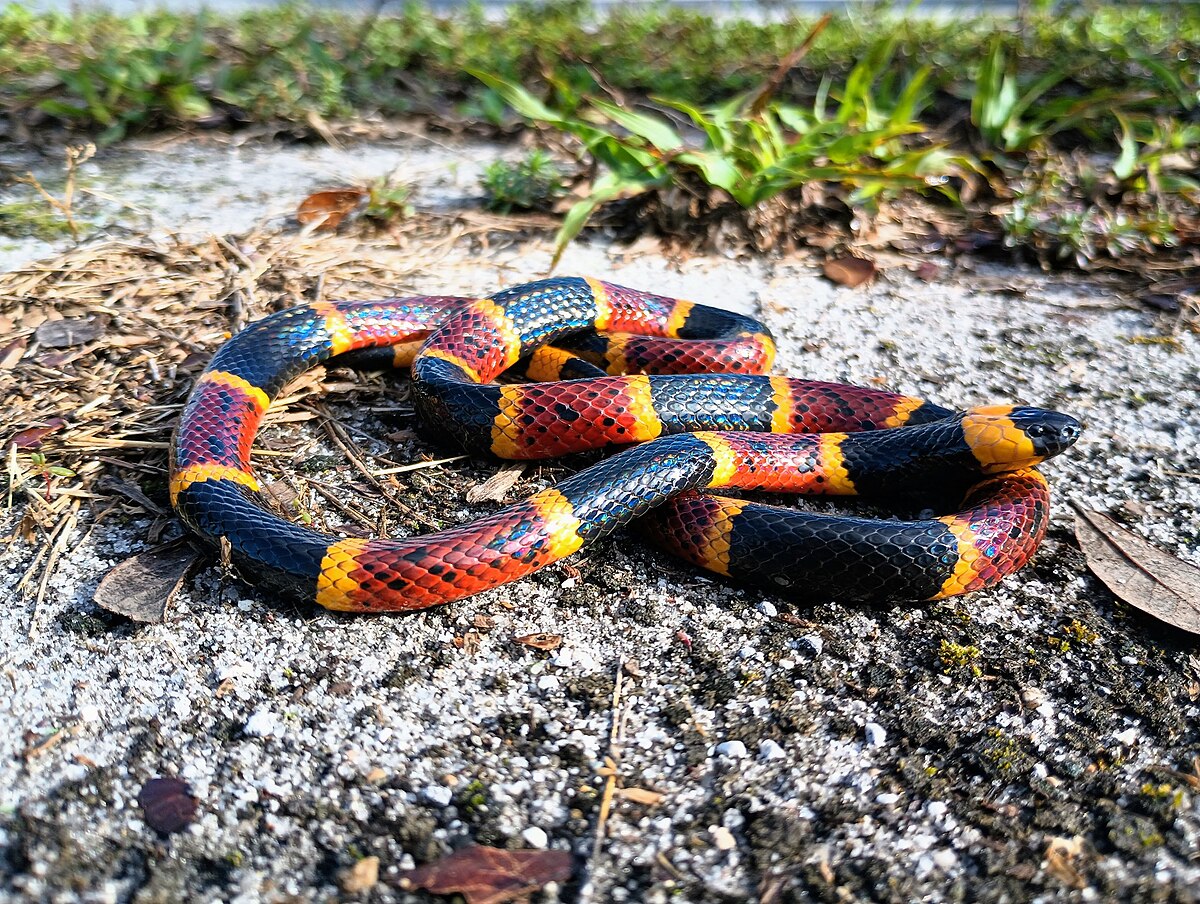
The eastern coral snake (Micrurus fulvius) is slender and brightly colored, with red, yellow, and black rings circling its body. A common rhyme used to identify it is “Red touch yellow, kill a fellow,” which distinguishes it from non-venomous look-alikes like the scarlet kingsnake.
Coral snakes have a potent neurotoxic venom that affects the nervous system, potentially causing paralysis or respiratory failure. Though shy and reluctant to bite, envenomation requires urgent medical treatment. Their small fangs and secretive habits mean bites are rare, but the effects can be life-threatening.
They are found throughout Florida in pine woods, sandy ridges, scrub, and leaf litter. Coral snakes are fossorial, spending much of their time underground or hidden beneath logs and debris. Their striking coloration warns predators, but they rely on stealth rather than aggression when encountering humans.
Burmese Python

The Burmese python (Python bivittatus) is a massive, non-venomous constrictor native to Southeast Asia that has become an invasive species in Florida, especially in the Everglades. These snakes can reach lengths of over 20 feet and weigh more than 200 pounds, making them one of the largest snakes in the world. Their patterned, tan-and-dark-brown bodies blend well into swampy vegetation, making them difficult to spot in the wild.
Although they are not venomous, Burmese pythons are powerful predators that kill by wrapping their muscular bodies around prey and suffocating it. They pose a threat to native wildlife, feeding on mammals, birds, reptiles, and even alligators. In residential areas bordering natural habitats, they may prey on pets like cats and small dogs. While attacks on humans are rare, their unpredictable strength demands caution.
In Florida, they are most heavily concentrated in the southern Everglades, where the warm, wet environment suits their survival and breeding. They were introduced through accidental or intentional releases by exotic pet owners and have since established a growing population. Due to their impact on native ecosystems, efforts are underway to control their numbers through organized removals and public reporting programs.
Florida Panther
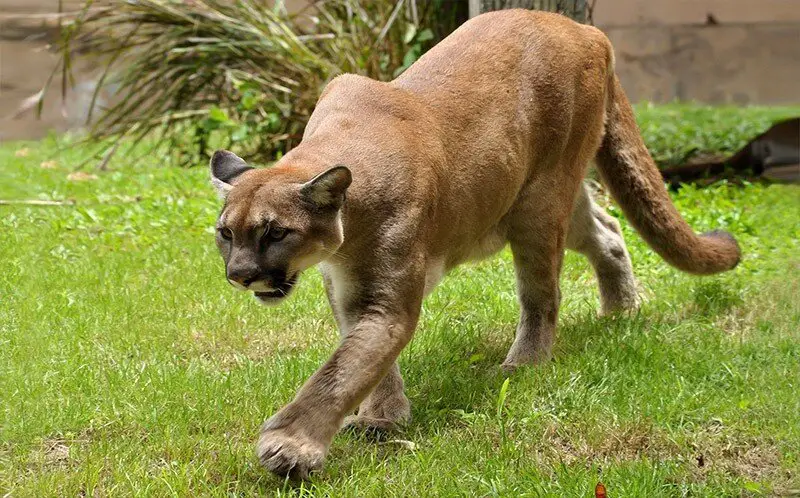
The Florida panther (Puma concolor coryi) is a rare and endangered subspecies of cougar found only in South Florida. It has a muscular build with a tawny coat and a long tail, typically weighing between 70 and 160 pounds. As one of the most iconic wild cats in the region, it plays a vital role in maintaining the balance of local ecosystems.
Florida panthers are elusive and avoid human contact, but like any large predator, they could become dangerous if cornered, provoked, or defending young. Though attacks on humans are extremely rare and there are no confirmed fatalities in Florida, experts advise giving them space if encountered.
These panthers inhabit forests, swamps, and pinelands of South Florida, particularly within Big Cypress National Preserve and Everglades National Park. Conservation efforts are ongoing to protect their shrinking habitat and increase their population, currently estimated at around 200 individuals.
Black Bear

The Florida black bear (Ursus americanus floridanus) is the largest land mammal in the state. It has a black coat, a short tail, and may have a brown muzzle or chest patch. Adult males can weigh over 400 pounds, while females are generally smaller. Despite their size, they are fast and can climb trees with ease.
These bears are typically shy and avoid humans, but they can become aggressive if startled, cornered, or if a mother bear is protecting her cubs. Conflicts often occur when bears become accustomed to human food sources, such as trash or pet food left outside, increasing the chances of a dangerous encounter.
They are found in forested areas throughout Florida, with larger populations in the Panhandle, Big Cypress, and Ocala regions. In recent years, bears have been seen more frequently in suburban neighborhoods due to urban expansion into their habitats. Wildlife officials advise residents to secure food sources and avoid direct contact.
Feral Hogs (Wild Boars)
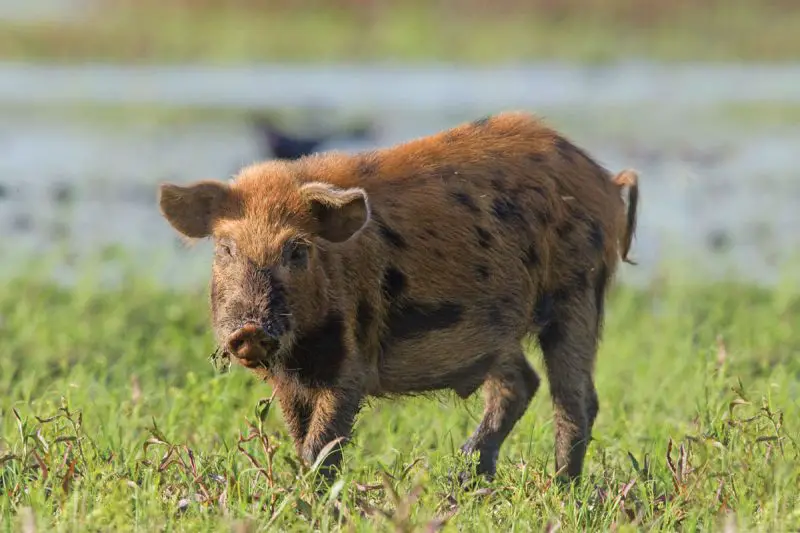
Feral hogs (Sus scrofa), also known as wild boars, are an invasive species found across much of Florida. They have coarse, bristled hair that can range from black to reddish-brown, and adult males often have sharp, curved tusks used for digging and defense. They are powerful and can weigh over 300 pounds.
These animals are known for their aggressive nature, especially when threatened or wounded. They may charge at humans with little warning, and their tusks can inflict deep, potentially life-threatening wounds. Attacks on hunters and hikers have been reported, particularly in rural or wooded areas.
Feral hogs live in forests, swamps, and agricultural lands across Florida, but they also thrive near suburban developments. They cause extensive ecological damage by rooting up vegetation, preying on native species, and spreading disease. Management programs include trapping and hunting to control their expanding population.
Bats (Certain Species)

Florida is home to several bat species, including the Brazilian free-tailed bat and the evening bat. These mammals play a crucial ecological role by controlling insect populations, but some species are known carriers of rabies, a fatal viral disease that can be transmitted to humans and pets.
Rabid bats may display unusual behavior, such as flying during the day, struggling to fly, or appearing tame. Bites or scratches may be so small they go unnoticed, but even minor contact can transmit the rabies virus. Immediate medical attention and post-exposure vaccination are essential if a person is potentially exposed.
Bats typically roost in trees, caves, old buildings, attics, and under bridges throughout Florida. Some species, like the Brazilian free-tailed bat, form large colonies, especially in urban or semi-urban areas. Human encounters often occur when bats accidentally enter homes or when people come across injured individuals on the ground. Although bats are essential for pest control and pollination, it’s important to never handle one with bare hands. Public health agencies strongly advise contacting animal control or wildlife experts for safe removal.
Bull Shark
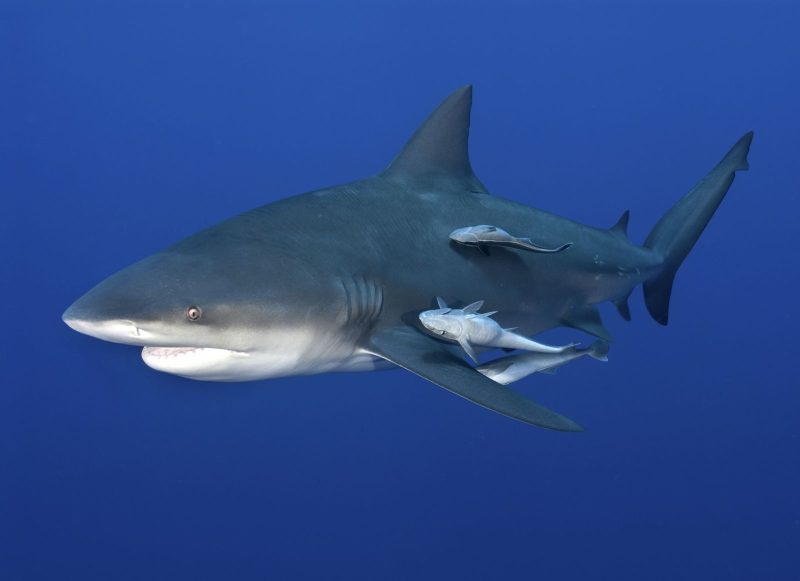
The bull shark (Carcharhinus leucas) is one of the most aggressive and dangerous shark species found in Florida. It has a stout, powerful body with a blunt snout and small eyes. Unlike many sharks, bull sharks can tolerate both saltwater and freshwater, allowing them to swim far up rivers and into estuaries.
This adaptability makes bull sharks a serious concern for human safety. They are among the top three shark species involved in unprovoked attacks on humans worldwide. Their aggressive nature, combined with their tendency to inhabit shallow, murky waters near beaches and river mouths, increases the likelihood of encounters.
Bull sharks are commonly found along Florida’s Gulf and Atlantic coasts, especially near river inlets, bays, and coastal lagoons. Sightings have occurred in places as far inland as the St. Johns River. Swimmers, surfers, and anglers should exercise caution in these areas, particularly during warmer months when sharks are more active.
Tiger Shark
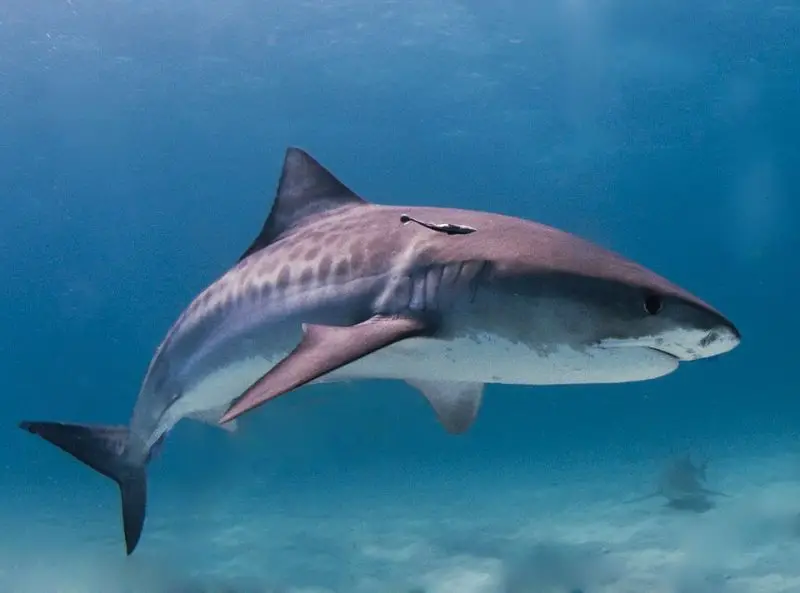
The tiger shark (Galeocerdo cuvier) is a large, blunt-nosed predator easily recognized by the dark, vertical stripes along its body—similar to a tiger’s pattern. Adults can reach lengths of up to 16 feet and are considered one of the most dangerous sharks in the ocean due to their size and feeding behavior.
Tiger sharks are known for their curiosity and unpredictable nature. They feed on a wide variety of prey, including fish, sea turtles, birds, and even garbage. This indiscriminate feeding makes them more likely to investigate or bite unfamiliar objects, including humans. They are second only to the great white shark in the number of recorded unprovoked attacks on people.
These sharks are found off both Florida coasts, especially around the Florida Keys and deeper offshore waters. They tend to stay near tropical and subtropical waters and are more active during the warmer seasons. While attacks are rare, their size and unpredictability make them potentially very dangerous.
Great Hammerhead Shark
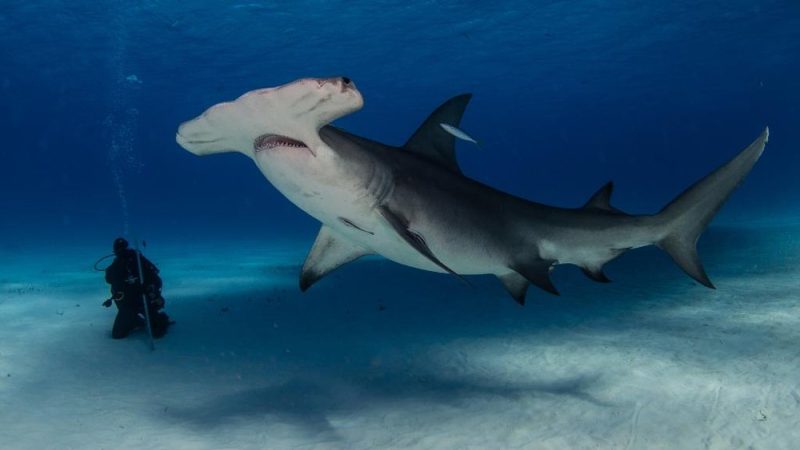
The great hammerhead shark (Sphyrna mokarran) is easily recognized by its distinctive hammer-shaped head, called a cephalofoil. It is the largest of all hammerhead species, reaching lengths up to 20 feet. Its unique head enhances sensory perception and maneuverability, helping it hunt stingrays and fish with precision.
Despite its intimidating appearance and size, the great hammerhead rarely attacks humans. However, due to its strength and sharp teeth, any encounter can be dangerous if provoked or mistaken. Most attacks are unprovoked but extremely rare, and fatalities are even less common.
Great hammerheads are found off the coasts of Florida, particularly in coral reefs, continental shelves, and nearshore waters. They tend to migrate seasonally and are more commonly seen in summer. Divers and swimmers should maintain distance and avoid approaching or cornering these powerful predators.
Portuguese Man O’ War
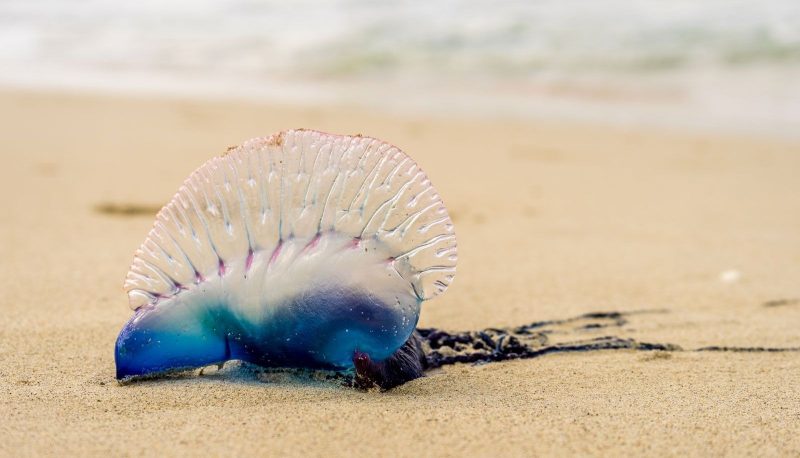
The Portuguese man o’ war (Physalia physalis) is often mistaken for a jellyfish but is actually a siphonophore—a colony of specialized organisms working together. It floats on the ocean surface with a translucent, balloon-like crest that can be tinted blue or purple, and trails long, venomous tentacles below.
These tentacles can extend up to 30 feet and contain stinging cells (nematocysts) capable of delivering painful and venomous stings. Contact can cause burning pain, welts, and severe allergic reactions, including difficulty breathing or even anaphylaxis in sensitive individuals. Stings may still occur even if the animal appears dead or washed ashore.
The Portuguese man o’ war is commonly found in the Atlantic Ocean and Gulf of Mexico, especially along Florida’s beaches during certain times of the year when strong winds push them to shore. Swimmers and beachgoers should always avoid touching them, even when they appear motionless on the sand.
Box Jellyfish
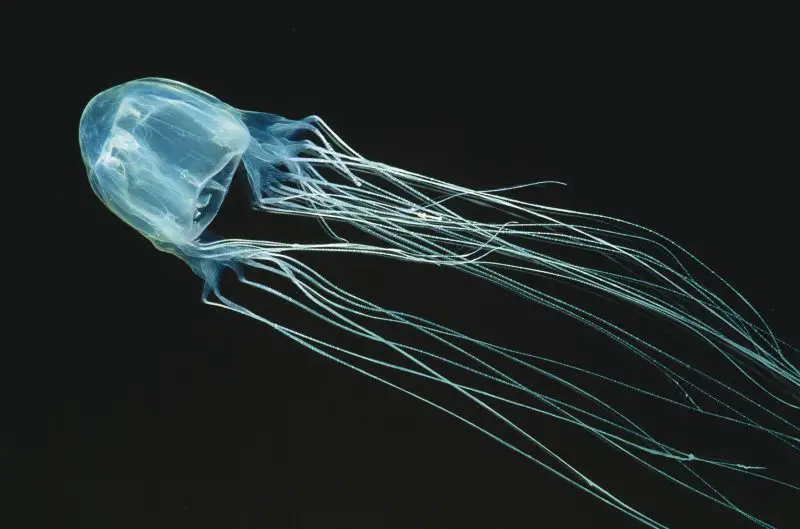
The box jellyfish (Chironex species and related genera) is considered one of the most venomous marine creatures in the world. It gets its name from its cube-shaped, transparent bell and long, trailing tentacles that are lined with stinging cells. While not native to Florida, some species—typically less dangerous than those in the Indo-Pacific—have occasionally been reported in Florida’s coastal waters.
The venom of some box jellyfish species can cause severe pain, skin necrosis, cardiac arrest, and even death within minutes. Although the species sighted in Florida are generally less potent, their sting can still lead to intense pain, blistering, and possible systemic symptoms. Any suspected sting should be treated immediately with medical attention and vinegar to neutralize nematocysts.
Sightings in Florida are rare and usually occur during warmer months in southern coastal areas. These jellyfish may be found near beaches after strong currents or storms. Swimmers should remain cautious when entering unfamiliar waters, especially when water visibility is low or warnings are posted.
Stingrays
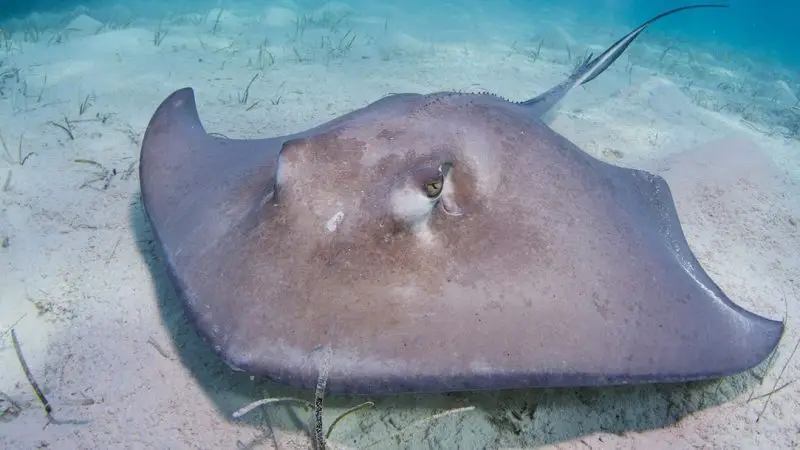
Stingrays are flat-bodied, bottom-dwelling marine animals commonly found in Florida’s shallow coastal waters, bays, and sandy beach areas. They often bury themselves in the sand for camouflage, making them difficult to spot. While not aggressive, stingrays will defend themselves if stepped on or threatened.
The primary defense of a stingray is its sharp, venomous barb located on the tail. When stepped on, it can whip the tail upward and puncture the skin, injecting venom that causes excruciating pain, swelling, and muscle cramps. In rare cases, the injury can become infected or lead to more serious complications.
Stingray encounters are common along Florida beaches, particularly in the Gulf of Mexico. To reduce the risk of injury, beachgoers are advised to perform the “stingray shuffle” by sliding their feet through the sand rather than stepping directly down. This movement alerts stingrays to your presence and gives them a chance to swim away.
Cone Snail
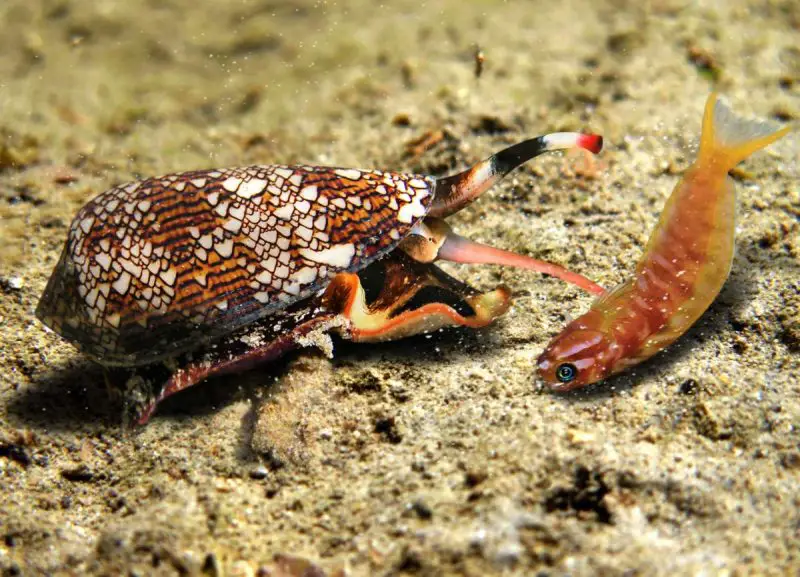
The cone snail (Conus species) is a beautiful yet dangerous marine mollusk found in shallow waters, tide pools, and coral reefs along Florida’s coastline. Its shell is often cone-shaped with intricate patterns and colors, making it attractive to collectors. Despite its harmless appearance, it possesses a potent venomous weapon.
Hidden within its body is a harpoon-like tooth used to inject venom into prey such as fish, worms, and small mollusks. This venom contains a complex mix of neurotoxins that can paralyze and kill. While human stings are extremely rare, they can be serious or even fatal, especially from larger species. The sting may initially feel like a bee sting but can quickly escalate to numbness, paralysis, or respiratory failure.
Cone snails are most often encountered in warm, shallow waters, particularly around coral and rocky areas. People are typically stung when handling live specimens without realizing the risk. If found, they should never be picked up or disturbed, and medical help should be sought immediately if a sting occurs.
Blue-Ringed Octopus
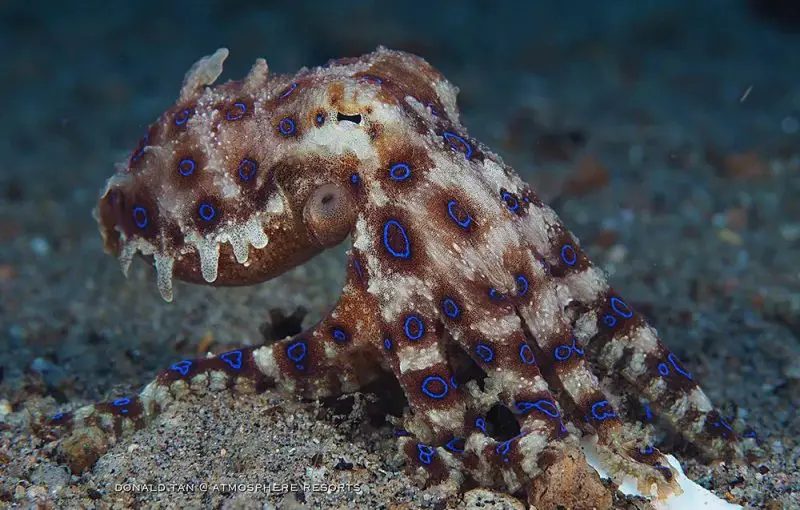
The blue-ringed octopus (Hapalochlaena species) is a small, vividly colored marine animal known for the iridescent blue rings that appear on its body when it feels threatened. While it is native to the Indo-Pacific region, rare sightings or aquarium releases have occasionally been reported in Florida’s coastal waters, although it is not considered a resident species.
Despite its small size—typically under 8 inches—the blue-ringed octopus carries venom strong enough to kill a human. It produces tetrodotoxin, a neurotoxin that can cause muscle paralysis, respiratory failure, and death within hours. The bite is often painless, and symptoms may not appear until it’s too late, making it especially dangerous.
Although actual encounters in Florida are extremely rare, the potential presence of such a venomous creature is reason for awareness. It tends to hide in rocky crevices, shells, or coral rubble in shallow waters. Divers and snorkelers should avoid touching unfamiliar marine animals and alert authorities if they suspect a sighting.
Africanized Honey Bees (“Killer Bees”)

Africanized honey bees (Apis mellifera scutellata hybrids), commonly called “killer bees,” are an aggressive hybrid of African and European honey bees. They look nearly identical to regular honey bees but are far more defensive and will respond to disturbances in large numbers. These bees often nest in wall cavities, trees, or underground.
When threatened, Africanized bees are known to swarm aggressively and pursue a perceived threat over long distances. Multiple stings can cause serious injury or death, particularly in individuals who are allergic or unable to escape the swarm quickly. Even people without allergies can suffer dangerous effects from the sheer number of stings.
They are increasingly found in South and Central Florida, particularly in warm urban and rural environments. Nests are often located near human structures, raising the risk of accidental disturbance. If encountered, it’s critical to leave the area immediately and contact a professional pest control service.
Fire Ants
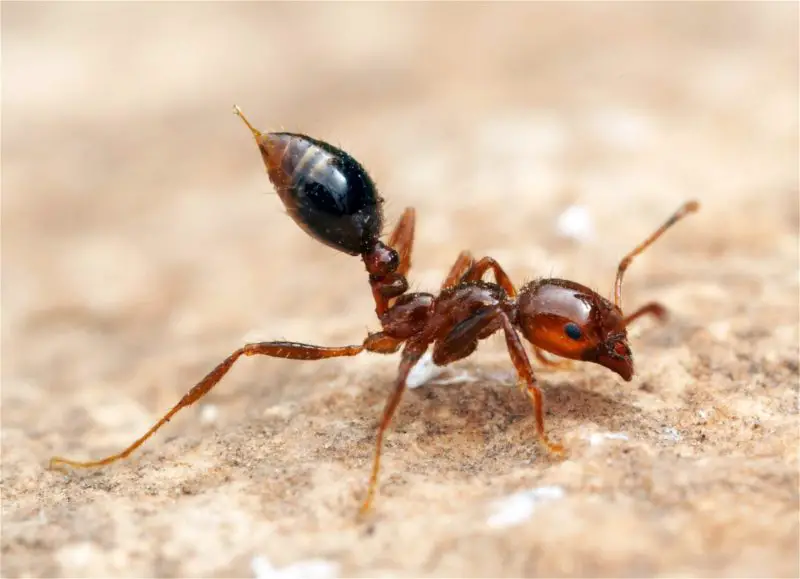
Fire ants (Solenopsis invicta) are invasive insects notorious for their painful stings and aggressive colony defense. They are small reddish-brown ants that build large, dome-shaped mounds in lawns, pastures, gardens, and along roadsides. These mounds often appear after rainfall and can house thousands of ants.
When disturbed, fire ants swarm quickly and bite to anchor themselves before delivering repeated stings with their venomous stingers. The stings produce burning pain followed by itchy, white pustules. In some cases, stings may trigger severe allergic reactions or anaphylaxis, requiring emergency treatment.
Fire ants are widespread throughout Florida and thrive in sunny, open areas. Infestations are common in both rural and suburban environments. Avoiding their mounds and using proper lawn management can help reduce the risk of encountering them.
Brown Widow Spider

The brown widow spider (Latrodectus geometricus) is a close relative of the black widow and is now more commonly found in Florida than its famous cousin. It can be identified by its light to dark brown body, striped legs, and an orange or yellow hourglass marking on the underside of the abdomen.
Like other widow spiders, the brown widow has neurotoxic venom, but its effects are generally milder. A bite may cause localized pain, redness, and muscle cramps but is rarely life-threatening. Brown widows are less reclusive than black widows and may bite when accidentally pressed or disturbed.
These spiders prefer to build their messy webs in sheltered areas such as mailboxes, patio furniture, plant pots, and under eaves. They are commonly found around homes in Florida, especially in warm, shaded corners. Care should be taken when working around potential web sites.
Black Widow Spider
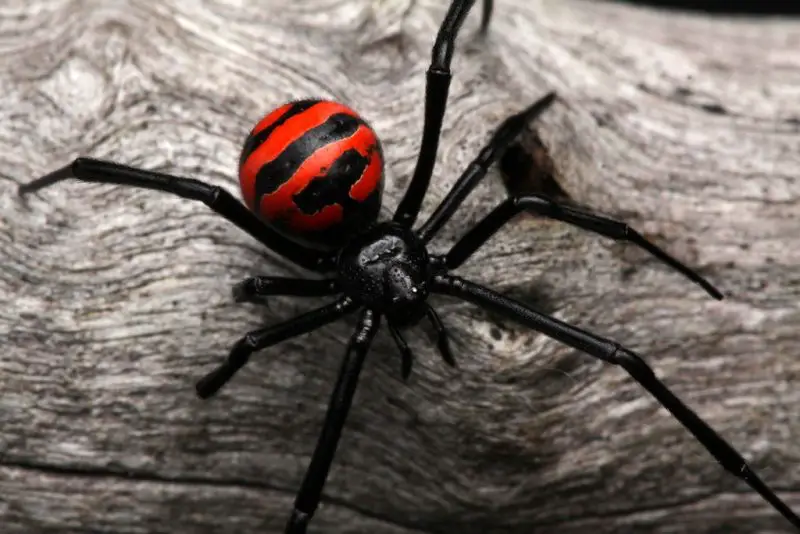
The black widow spider (Latrodectus mactans) is one of the most recognizable and feared spiders in North America. Females are shiny black with a distinct red or orange hourglass marking on the underside of the abdomen. They are typically about 1.5 inches wide when legs are extended.
Black widow venom is highly neurotoxic and can cause intense pain, muscle cramps, nausea, and sweating within hours of a bite. While bites are rarely fatal with modern treatment, they can be particularly dangerous for young children, the elderly, or those with compromised immune systems.
Black widows are found throughout Florida, often hiding in dark, undisturbed areas such as woodpiles, sheds, garages, and crawl spaces. They are non-aggressive and bite only in self-defense. Wearing gloves and checking outdoor storage areas can help prevent accidental contact.
Osprey and Large Raptors
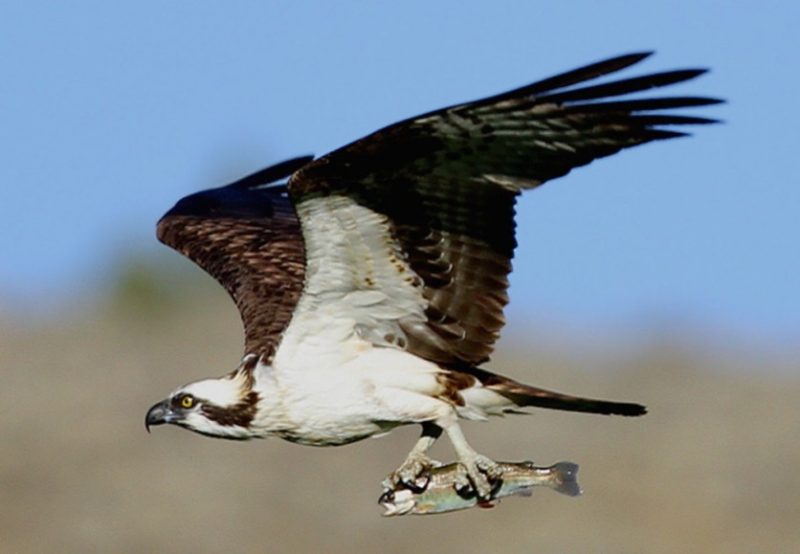
Ospreys (Pandion haliaetus) and other large raptors such as hawks and eagles are impressive birds of prey commonly found throughout Florida. These birds have keen eyesight and strong, curved beaks designed for hunting fish, small mammals, and other birds. They typically have powerful talons that help them capture and kill their prey efficiently.
While these raptors are not usually aggressive toward humans, they can become defensive and attack if their nests or young are threatened. Such attacks involve sharp talon strikes that can cause deep puncture wounds and significant injury. Nesting areas, especially during breeding season, should be approached with caution or avoided altogether.
Ospreys are often seen nesting near coastlines, lakes, and rivers, while larger raptors like bald eagles inhabit a range of habitats including forests and wetlands. These birds play an important role in Florida’s ecosystems, but respecting their space helps prevent dangerous encounters.
Giant African Land Snail (Invasive)
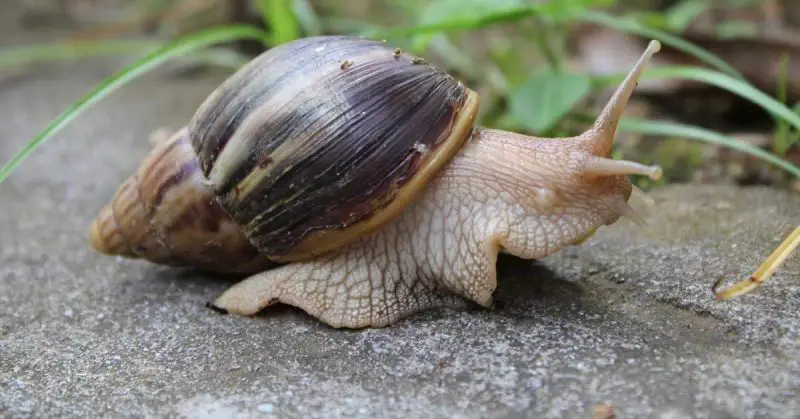
The giant African land snail (Achatina fulica) is a large, non-native snail species that has become invasive in parts of Florida. Its shell can grow up to 8 inches long, with brown and cream-colored stripes, making it one of the largest land snails in the world. While the snail itself is not venomous or aggressive, it poses indirect risks.
This snail is a known carrier of parasitic nematodes, such as rat lungworm (Angiostrongylus cantonensis), which can cause serious neurological diseases in humans if ingested accidentally. Contamination can occur through contact with the snail’s mucus or by consuming unwashed produce that has come into contact with the snails.
Beyond health risks, giant African land snails cause significant agricultural damage by feeding on a wide variety of plants, including crops and ornamental species. Their voracious appetite disrupts local ecosystems and threatens native plants. Florida has active efforts to control and eradicate populations to prevent further spread.
FAQ about Most Dangerous Animals in Florida
What are some of the most dangerous animals found in Florida?
Florida is home to a variety of dangerous animals including the American alligator, bull sharks, venomous snakes like the eastern diamondback rattlesnake and cottonmouth, as well as aggressive insects such as Africanized honey bees. Additionally, invasive species like the Burmese python and feral hogs pose significant risks.
Are alligators common in Florida, and how dangerous are they?
American alligators are widespread throughout Florida’s freshwater habitats such as swamps, lakes, and rivers. While generally shy, they can be dangerous if provoked or if humans get too close, especially during nesting season. Attacks are rare but can be fatal due to their powerful bite.
Which venomous snakes should I watch out for in Florida?
Florida is home to several venomous snakes, including the eastern diamondback rattlesnake, cottonmouth (water moccasin), coral snake, and pygmy rattlesnake. Each has venom that can cause serious injury, and some bites can be fatal without prompt medical treatment.
How dangerous are sharks in Florida waters?
Bull sharks and tiger sharks are among the most dangerous sharks in Florida coastal waters, known for aggressive behavior and involvement in unprovoked attacks on humans. Great hammerhead sharks are also present but rarely attack humans.
Can insects like bees and ants be dangerous in Florida?
Yes. Africanized honey bees, or “killer bees,” are extremely aggressive and can swarm, causing multiple stings that may be fatal to allergic individuals. Fire ants are widespread and deliver painful stings that can cause allergic reactions or infections.
Are there any dangerous marine animals besides sharks in Florida?
Yes. The Portuguese man o’ war and cone snails are venomous marine creatures found in Florida waters. Stingrays also pose a risk in shallow waters, as their venomous barbs can cause intense pain when stepped on.
What should I do if I encounter a dangerous animal in Florida?
It’s important to keep a safe distance and avoid provoking the animal. For snakes or venomous marine life, seek immediate medical attention if bitten or stung. For aggressive insects or animals like alligators and feral hogs, retreat calmly and contact local wildlife authorities if necessary.
Are invasive species like the Burmese python a threat to Florida’s ecosystem and people?
Yes. Burmese pythons are large, powerful constrictors that prey on native wildlife and occasionally pets. Although not venomous, they can be unpredictable and dangerous if approached. Their presence disrupts local ecosystems and ongoing removal efforts aim to control their numbers.


